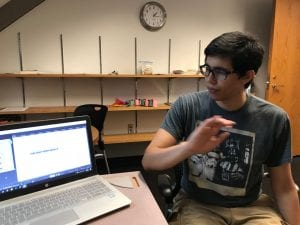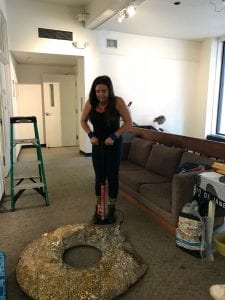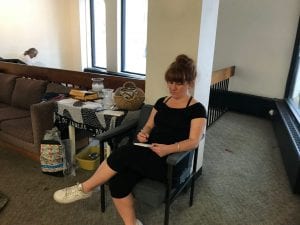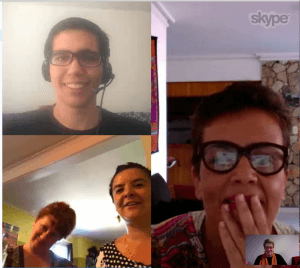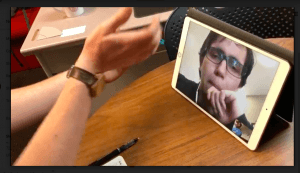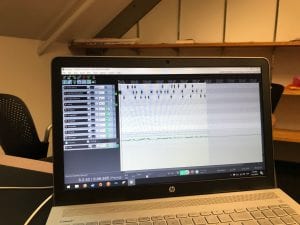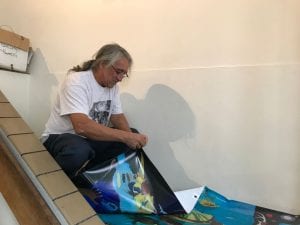Methodology:
Aguakinesis is a transnational, collaborative, story-based interdisciplinary arts project that involves individuals from the Seneca Nation, Colombia, Ecuador, Brazil, Venezuela, Mexico, Cornell, and the city of Ithaca. The group worked together over a period of a year sharing stories of water and indigenous knowledges, and then created artistic interpretations of these stories, which were presented in the show. The exhibition also featured works by other artists from throughout the Americas.
This multimedia exhibition includes interactive exhibits, music, video, photos, live performance, and (in Ithaca) a revisiting of the Balcón Criollo, featuring artifacts from the homes of community members.
Aguakinesis proposes to bring into dialogue academic discourse from several disciplines, with knowledge from grassroots communities to explore our understandings about water. What do we know? How do we valorize different types of knowledge? How can we think more strategically and effectively when we take into account rich, profound dialogues with other knowledge traditions?
Genealogically, the roots of this practice derive from the philosophy of Paulo Freire, whose Pedagogy of the Oppressed, 1968, was deeply influenced by philosophical concepts drawn from phenomenology and the philosophy of language. Freire has been internationally celebrated for this work, especially as it reflects on pedagogical theory and practice. According to Richard Shaull, summarizing Freire’s position: “There is no such thing as a neutral education process. Education either functions as an instrument which is used to facilitate the integration of generations into the logic of the present system and bring about conformity to it, or it becomes the ‘practice of freedom’, the means by which men and women deal critically with reality and discover how to participate in the transformation of their world.”
Metodología
Aguakinesis es un proyecto interdisciplinario de artes de colaboración transnacional basado en historias que involucra a personas de la Nación Séneca, Colombia, México, Ecuador, Brazil, Venezuela, Cornell e Itaca. Durante un año, el grupo trabajó en conjunto y compartió historias sobre el agua y el conocimiento indígena. La comunicación a través de skype fue vital para el progreso de este proyecto. Permitió que el grupo compartiera sus historias sobre el agua y sus percepciones / hallazgos al observar el agua. Luego crearon interpretaciones artísticas de estas historias, que se presentaron en el espectáculo. Además, en la exposición se presentarán obras independientes de otros artistas en todo el continente americano.
La instalación multimedia incluye exhibiciones interactivas, música, vídeos, fotos, presentaciones en vivo en bucle, y una revisión de Balcón Criollo (una colección de artefactos de hogares de miembros de la comunidad que se inauguró el año).
Aguakinesis propone poner en dialogo científicos de varias disciplinas con comunidades de base para explorar nuestros conocimientos sobre el agua. ¿Qué sabemos? ¿Cuales conocimientos se valorizan? ¿Como nos ayuda pensar mas efectivamente y estratégicamente al tener diálogos ricos y profundos con otras formas y tradiciones de conocimiento?
Genealógicamente, las raíces de esta práctica derivan de la filosofia de Paulo Freire, Pedagogia del oprimido, 1968, obra influida por las lineas filosoficas de fenomenologia y filosofia del lenguaje. Freire ha sido mundialmente conocido por esta obra, sobre todo su influencia en la teoría y práctica pedagógicas. Segun el pensador Richard Shaull, resumiendo la posición de Freire: “There is no such thing as a neutral education process. Education either functions as an instrument which is used to facilitate the integration of generations into the logic of the present system and bring about conformity to it, or it becomes the ‘practice of freedom’, the means by which men and women deal critically with reality and discover how to participate in the transformation of their world.”
